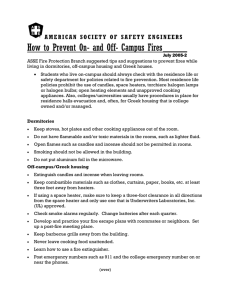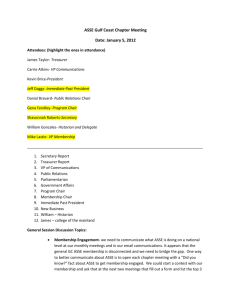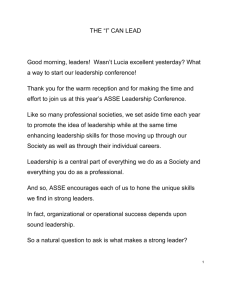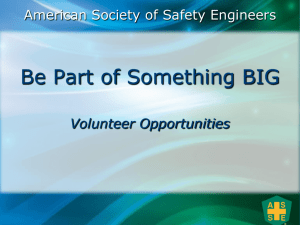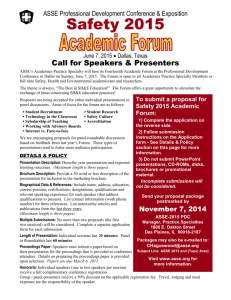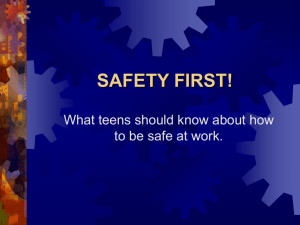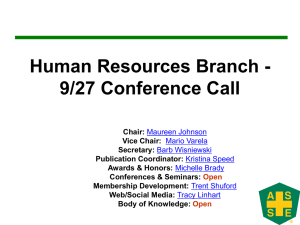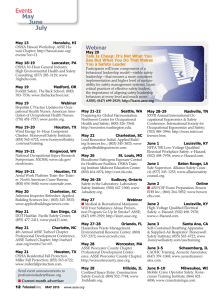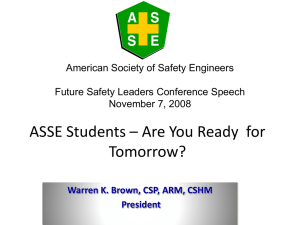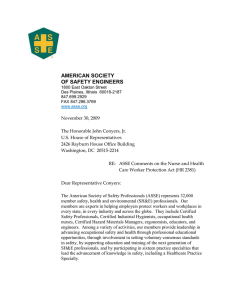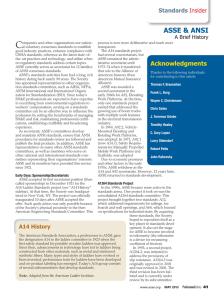Develop Strategic Plan
advertisement
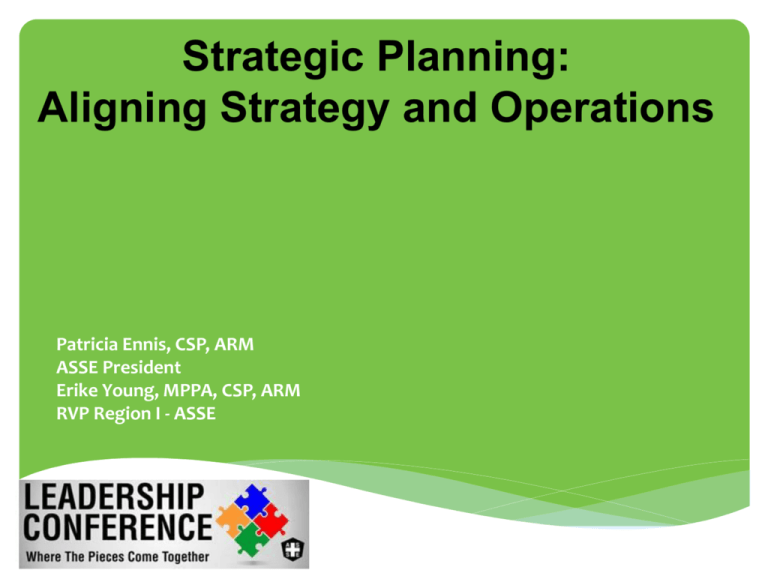
Strategic Planning: Aligning Strategy and Operations Patricia Ennis, CSP, ARM ASSE President Erike Young, MPPA, CSP, ARM RVP Region I - ASSE Lessons from Alice in Wonderland The Society’s Mission and Vision Mission Statement ASSE is a global association of safety, health and environmental professionals dedicated to the advancement of its members and the profession through education and advocacy. Vision Statement ASSE is a global advocate and premier leader for the safety, health, and environmental professional and the profession. Society Goals and Objectives Society Goals and Objectives Society Goals and Objectives Society Goals and Objectives Society Goals and Objectives Society Goals and Objectives Society’s Accomplishments Creation of Risk Assessment Institute Creation of Center for Safety and Health Sustainability Secretariat for ANSI and ISO standards Increase in the number of webinars Creation and support of Practice Specialties Increase number of international chapters Society’s Accomplishments Creation of Body of Knowledge Testifying on regulatory issues Collaboration with other societies Changes in Code of Conduct Proposed reorganization of ASSE Governance Should a Region/Chapter have a different mission, vision, values than Society? Companywide Values: B R O A D More Specific 1. Dedication to every client's success 2. Innovation that matters, for our company and for the world 3. Trust and personal responsibility in all relationships Although the sub-groups within a “family” share a set of broad values at the top, each functional group may have its own set of values that reflect its own set of specific duties. Global Procurement Values: 1. 2. 3. Understanding Integrity and teamwork Initiative and urgency It doesn’t mean the lower group conflicts with the higher group (in fact, they usually jibe quite well). It just means the work is getting more specific. What is Strategic Planning? A systematic approach through which an organization agrees on priorities that are essential to its mission and responsive to its environment. Data based Guides budget decisions Continues when leadership changes Involves stakeholders in development What is Strategic Planning is NOT Done annually Should be reviewed annually Done in a vacuum An operations plan Operations plans are done annually and are specific to the objectives How Long Should a Plan Be? As short and simple as possible! Format that easily says what you intend to do and how Long enough to give guidance to annual operating plan Not so long that nobody will read or use it! Drives Budget and Resource Decisions What resources are needed to support the program goals? Equipment/software Technology Marketing Expertise Other…. Elements to Effective Planning Process Focus on the most important issues Be willing to question the status quo Produce a written document that will be understood after leadership changes Translate it into an annual operating plan Our culture “I don't know how it started, either. All I know is that it's part of our organizational culture." A Three-Phase Process Phase I: Gather Data •Document the current state of reality and desired future position of the chapter •Review Society Mission, Vision and Values •Review data (attendance, survey, etc..) •Conduct survey of leadership •SWOT Analysis Phase II: Develop Strategic Plan •Create a framework for broad direction and priorities for the future in strategic plan document •Chapter specific Mission, Vision, Values •Strategic goals •Objectives Phase III: Develop Implementation Plan •Develop and document specific steps that will be taken in order to execute the objectives identified in the strategic plan •Develop implementation plan that includes •Objectives •Tactics •Indicators Puget Sound Chapter SWOT Fall 2013 Strengths •Name Recognition •Growing Executive Committee Involvement •2 Geographical & 1 Student Sections •Dedicated Core Group •Financial Stability •Wide Industrial Member Base •Objectives Clearly Identified and Communicated to Members Weaknesses •Lack of Support from Large Companies, •Limited Member Participation / Too Few Committee Members •Not Consistently Utilizing Effective Communication tools to reach Members •Little Community Involvement •Not Strong Ties to Geographical Sections •Not Enough Member Recognition •Chapter Seen as Using Old / Stodgy Methods and Procedures Opportunities/Successes •Younger Executive Committee Open to Change •Use of GoToMeeting Helping Executive Committee Participation •CWU Student Section has Strong Leader •Using Co-opetition – For Joint Meetings With Other Associations • PDC with Student Section in Spring •Field/Site Technical Meetings 2 Planned for this Current Year Threats •Many Safety Organizations Competing in Area •Members Lack of discretionary Time for Chapter Functions •Younger members put a higher value on personal time •No Forward Looking Plan for Revenue Generation McKinsey 7S Value-Based Leadership/Planning Placing Shared Values in the middle of the model emphasizes that these values are central to the development of all the other critical elements. An organization’s structure, strategy, systems, style, staff and skills all stem from why the organization was originally created, and what it stands for. As the values change, so do all the other elements. http://www.mindtools.com/pages/article /newSTR_91.htm Balanced Scorecard The balanced scorecard is a strategic planning and management system that is used extensively in business and industry, government, and nonprofit organizations worldwide to align business activities to the vision and strategy of the organization, improve internal and external communications, and monitor organization performance against strategic goals. http://www.balancedscorecard.org/Res ources/AbouttheBalancedScorecard/ta bid/55/Default.aspx A Three-Phase Process Phase I: Gather Data • Document the current state of reality and desired future position of the chapter • Review Society Mission, Vision and Values • Review data (attendance, survey, etc..) • Conduct survey of leadership • SWOT Analysis Phase II: Develop Strategic Plan • Create a framework for broad direction and priorities for the future in strategic plan document • Chapter specific Mission, Vision, Values • Strategic goals • Objectives Phase III: Develop Implementation Plan • Develop and document specific steps that will be taken in order to execute the objectives identified in the strategic plan • Develop implementation plan that includes • Objectives • Tactics • Indicators Mission, Vision, Values • What’s the difference between mission and vision? • MISSIONary • VISIONary Someone who carries out the work Someone who sees what is possible • Our mission is what we do. • Our vision is the future we want to create. • Our values are the guardrails that keep us on track. Mission Critical Questions Describe what you do and for whom… It doesn’t have to be earth-shattering… Be what your core competency is… But would your mother understand it? But does it inspire you? But does it align with what you do best? Vision The vision should be very attractive… Chateau with formal gardens? … but still realistic. Center-hall colonial! Region I Mission In support of the Society’s mission Region I ROC will: MISSION is what we do: 1. Provide guidance, tools, and resources to chapter leadership to enable efficient operations and maintenance of a chapter’s charter; 2. Provide and promote professional development and networking opportunities to Region I members; 3. Act as good stewards of Region and Chapter resources; and, 4. Provide guidance to the COMRA and the Board of Directors on issues affecting chapters and members. Region I Vision VISION is the future we want to create: ASSE Chapters and Members in Region I are recognized as the premier safety and health resource by employers, regulators, communities, and fellow safety professionals. A Three-Phase Process Phase I: Gather Data •Document the current state of reality and desired future position of the chapter •Review Society Mission, Vision and Values •Review data (attendance, survey, etc..) •Conduct survey of leadership •SWOT Analysis Phase II: Develop Strategic Plan •Create a framework for broad direction and priorities for the future in strategic plan document •Chapter specific Mission, Vision, Values •Strategic goals •Objectives Phase III: Develop Implementation Plan •Develop and document specific steps that will be taken in order to execute the objectives identified in the strategic plan •Develop implementation plan that includes •Objectives •Tactics •Indicators Annual Operation Plan Provide enough detail to guide the work Format that allows for reports on progress towards goals and objectives Shows consistency with overall priorities Annual Operation Plan Operationalizes strategic plan! Specifies process and outcome objectives Developed with/by position responsible for area Format makes monitoring easy Has realistic budgets to support each area Discussion What are some actions to address the following? Succession planning and leadership turnover Member Recruitment and retention Member participation Employer support Revenue
